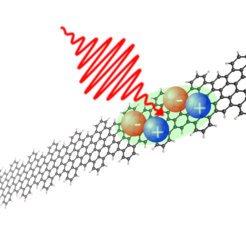Measuring optoelectronic properties: graphene nanoribbons proved to be ideal for photodetectors and telecommunications devices
Investigating the optical properties of graphene nanoribbons, a team of international scientists, among others of the Max Planck Institute for Polymer Research (MPI-P) in Mainz, has demonstrated the capability of this material to absorb and emit light. Based on these findings, the industrial use of graphene nanoribbons in different optoelectronic devices and telecommunications draws closer, paving the way toward graphene-based lasers and a highly efficient data transfer.
Graphene nanoribbons (GNRs) are ideal candidates for optoelectronic applications to generate, detect and control light as well as to absorb and convert light into energy – a promising use, for example in photovoltaics. The one-dimensional nanostructures consist of strips of graphene that are typically less than five nanometers wide. Graphene itself, shaped like a honeycomb lattice, is comprised of a single atomic plane of graphite. Measuring the GNRs’ ultrafast processes following optical excitation, a team of international scientists from Germany, Italy and Austria has been able to obtain fundamental insights into the material’s optoelectronic properties. The energy landscape and the relaxation dynamics have been elucidated and the findings are also supported by theoretical approaches that have been used to interpret the measurements. “In order to produce high-quality samples of GNRs that form the basis of our research project, we used the bottom-up molecular synthesis, developed in 2013 at the MPI-P,” adds Dr. Akimitsu Narita, project leader at the MPI-P. “This way, we could ensure atomically precise GNR structures suitable for our studies and for possible future applications.”
GNRs for future optoelectronics and telecommunications

Due to their unidimensional structure, GNRs display a strong coupling between light and bound states called excitons as well as biexcitons. An exciton is formed when an electron and a hole are attracted to each other instead of moving freely inside the material. As a bound state it is also able to store and release energy. Moreover, excitons can form so-called biexcitons, another bound state that can serve as an additional channel to store energy. GNRs initiate a variety of electronic mechanisms after having been illuminated by a light pulse, mainly involving excitons and biexcitons. Since these processes evolve on ultrashort timescales, they can only be studied using optical methods, such as the time-resolved spectroscopy. This technique investigates the photophysics of materials by means of ultrashort laser pulses. Thus, the scientists employed a self-developed system for time-resolved spectroscopy with extremely high temporal resolution and observed processes at time scales ranging from femto- to picoseconds, that is between one quadrillionth and one trillionth of a second. The researchers found exciton-exciton annihilation, where – after interaction between two excitons – one is promoted to a higher energy level while the other recombines to the ground state. Moreover, stimulated emission was demonstrated arising from strongly bound biexcitons. These excitation and relaxation dynamics can be used as benchmarks for future integrations of GNRs in photonic and optoelectronic devices. For instance, the strong stimulated emission makes the GNRs ideal candidates for tunable active materials used in lasers and photodetectors. To meet the ever more demanding standards in telecommunications, the findings can be applied to develop new generations of ultrafast optical switches for high-speed optical telecommunications.
About the project
Further developing the field of graphene nanomaterials for future optoelectronic devices and high-speed telecommunications, the joint project involves the following European research facilities: the Max Planck Institute for Polymer Research in Mainz, Germany, the Department of Physics at the Politecnico di Milano, Italy, the Department of Physics, Informatics and Mathematics at the University of Modena and Reggio Emilia, Italy, the National Research Council of Italy (IFN and NANO Institutes), and the Institute of Physics at the University of Graz, Austria. The project is financed, among others, by the DFG priority program “Graphene” (SPP 1459) and the European Union Project “Molecular Quantum Spintronics” (MoQuaS).









